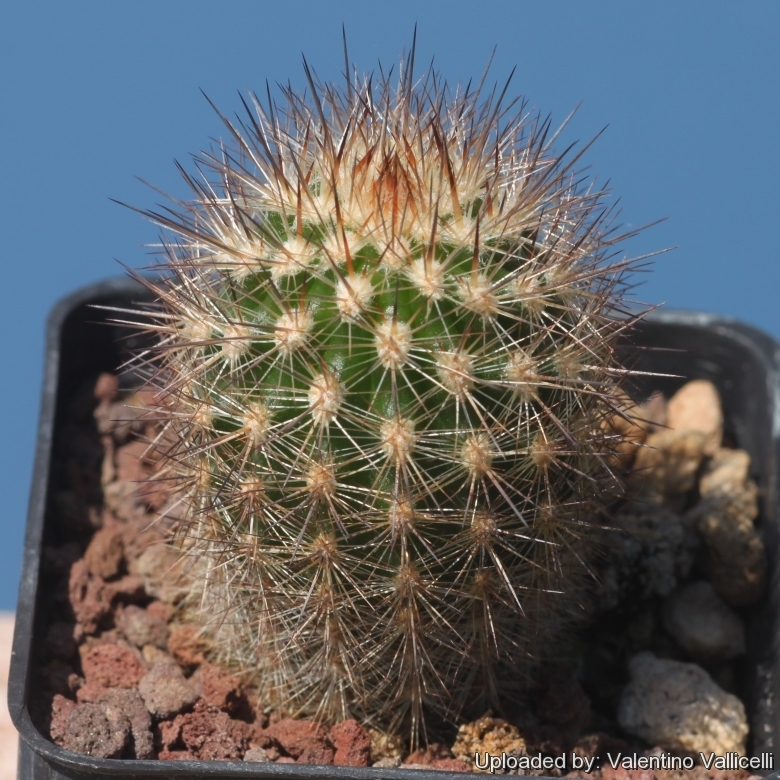= Arequipa spinosissima F.Ritter
Taxon 13: 115. 1964
Accepted Scientific Name: Oreocereus hempelianus (Gürke) D.R.Hunt
Bradleya 5: 93 (1987)

Borzicactus hempelianus var. spinosissimus (Arequipa spinosissima) Photo by: Valentino Vallicelli
Origin and Habitat: Mountains of South Peru (Arequipa, Ayacucho)
Altitude range: 800-2500 metres above sea level.
Habit: The species grows in Andean shrubland on rocky and sandy soils where is locally abundant and frequent. At lower altitudes it is often found growing together with Weberbauerocereus weberbaueriSN|8785]]SN|8785]].
Synonyms:
See all synonyms of Oreocereus hempelianus
back
Accepted name in llifle Database:Oreocereus hempelianus (Gürke) D.R.HuntBradleya 5: 93 (1987)Synonymy: 29
back
Common Names include:
RUSSIAN (Русский): Арекипа колючейшая
SPANISH (Español): Achacaño, Arequipa
Description: Arequipa spinosissimaSN|23801]]SN|23801]] (Borzicactus hempelianusSN|3800]]SN|3800]] var. spinosissimus) is a local or morphological form of the widespread and variable Oreocereus hempelianusSN|3798]]SN|3798]]. It has more numerous spines (up to 10 centrals and up to 30 radials). More recent observations of the extent of variation in Oreocereus hempelianusSN|3798]]SN|3798]] populations has led many authors to conclude that the distinguishing characteristics of Arequipa spinosissimaSN|23801]]SN|23801]] are not sufficiently distinct to deserve its own formal status. Arequipa spinosissimaSN|23801]]SN|23801]] should be synonymized with O. hempelianus.
Habitat: It is a cylindrical cactus simple or clustering from base with age with dense short brown spines and bright purple/red flowers when mature.
Stem: Spherical at first becoming elongated and eventually short-cylindric with age, erect or decumbent up to 30-40 (rarely 60) cm tall, 10-15 cm across, usually greyish-green or glaucous green.
Ribs: 10-20 flattened and large, 5-15 mm distant.
Spines: Very variable yellow to reddish, becoming dull grey.
Central spines: (1-)3-6(-10), up to 5 cm often curved, whitish, brown or nearly black, flexible.
Radial spines: (8-)10-15(-30), 1-3 cm long, needle-like to finely bristle-like, diverging, yellowish to glassy white.
Flowers: Arising near apex, 5-7,5 cm long, 2,5-3,5 cm scross, scarlet to purplish red, tube slightly curved, open to one side, the scales densely and softly hairy in the axil, limb more or less oblique, the segments acute.
Fruit: Barrel shaped to ovoid about 1,5-2,5 cm in diameter, yellowish, thin-walled, opening basally.
Bibliography: Major references and further lectures
1) Edward Anderson “The Cactus family” Timber Press, Incorporated, 2001
2) James Cullen, Sabina G. Knees, H. Suzanne Cubey "The European Garden Flora Flowering Plants: A Manual for the Identification of Plants Cultivated in Europe, Both Out-of-Doors and Under Glass" Cambridge University Press, 11/Aug/2011
3) David R Hunt; Nigel P Taylor; Graham Charles; International Cactaceae Systematics Group. "The New Cactus Lexicon" dh books, 2006
4) Urs Eggli, Leonard E. Newton: “Etymological Dictionary of Succulent Plant Names” Springer, Berlin/Heidelberg 2010
5) Willy Cullmann, Erich Götz (Dozent Dr.), Gerhard Gröner “The encyclopedia of cacti” Timber Press, 1987
9) E Haustein “Der Kosmos Kakteenfuehrer (the Kosmos Cactus Guide)” Balogh Scientific Books, United States, 01/Dec/1998
10) Cáceres, F., Faundez, L., Guerrero, P., Saldivia, P. & Walter, H.E. 2013. Oreocereus hempelianus. In: IUCN 2013. "IUCN Red List of Threatened Species." Version 2013.2. <www.iucnredlist.org>. Downloaded on 05 December 2013.
Cultivation and Propagation: This is a a much decorative frost hardy cactus easily found in cultivation.
Soil: Grow it in a rich and particularly draining substratum, as it is very sensitive to rottenness when in presence of humidity and low temperatures and let the soil dry out between waterings.
Water: In summer, during the vegetative period, it must be regularly watered, but allowing the substratum to completely dry up before irrigating again; in winter, it’s to be kept dry. Preferable not to water on overcast days, humid days or cold winter days.
Hardiness: Hardy to -7°, but tolerate temperatures down to -12° C for short periods if very dry. However in cultivation it is better not to expose it to below zero temperatures, especially if in presence of high atmospheric humidity as it is particularly sensitive to root rot. However in cultivation it is better not to expose it to temperatures lower than -5° C, even if in an aerated and protected location, in order to avoid the formation of anti-aesthetic spots on the epidermis.
Exposure: It need full sun exposures with ample airflow to produce dense hairs, but, as a former mountain dweller, does not care for extremely high temperatures in summer.
Maintenance: Repot in the spring, when their roots become cramped. Generally, they should be repotted every other year in order to provide fresh soil. After repotting, do not water for a week or more.
Use: Excellent as landscape or patio plant. It is suitable for small “desert” gardens, in association with other xerophytes. Where the open air cultivation is not possible due to the climate, it is to be cultivated in pot in order to shelter it in winter.
Propagation: By seeds and by cuttings, provided left drying up well, in summer.










